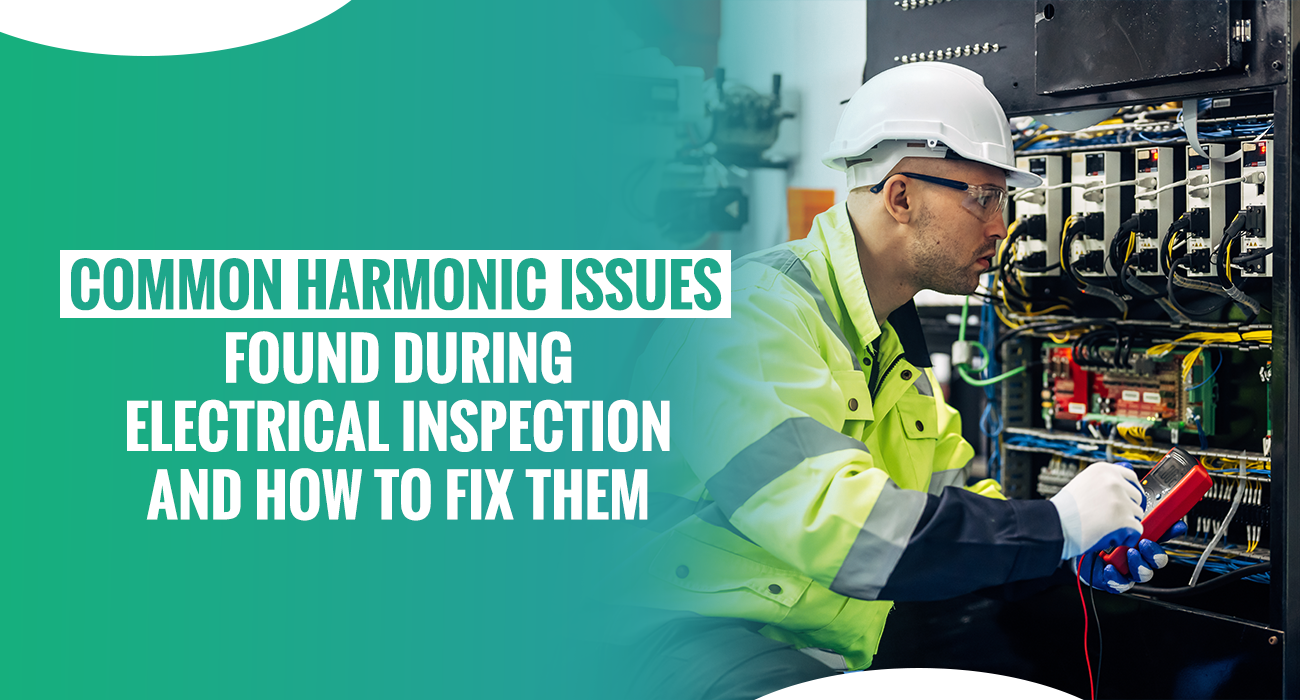
Common Harmonic Issues Found During Electrical Inspection and How to Fix Them
Electrical systems in industries, commercial buildings, hospitals, and critical infrastructure are becoming increasingly complex. Ensuring their reliable operation requires more than visual inspections or routine checks. Modern inspections now emphasize power quality analysis, which measures voltage stability, current, frequency, and overall system health, and harmonic analysis, which identifies waveform distortions caused by non-linear loads. Together, these analyses help detect issues that can compromise efficiency, safety, and equipment lifespan.
Harmonics are primarily generated by equipment such as variable frequency drives (VFDs), uninterruptible power supplies (UPS), LED lighting, and rectifiers. If left unchecked, they can cause transformer overheating, motor vibration, neutral conductor overload, and malfunctions in sensitive electronics. On-site inspections using power quality analysis and harmonic analysis enable early detection and timely corrective actions, reducing downtime and preventing costly failures.
Understanding Harmonics and Power Quality
Power quality analysis assesses electrical parameters such as voltage stability, frequency variations, current harmonics, and load balance to ensure optimal system operation. Poor power quality can result in energy losses, equipment malfunction, and safety hazards. Meanwhile, harmonic analysis focuses specifically on identifying waveform distortions—non-sinusoidal currents or voltages—that can damage equipment over time.
Industries often overlook harmonics because their effects are not visible. However, even small distortions can gradually affect transformers, motors, and sensitive devices. For instance, in commercial offices, harmonics from LED lighting and HVAC systems can interfere with IT equipment, causing unexpected shutdowns. On-site harmonic analysis helps detect these distortions early, allowing engineers to implement mitigation strategies and protect critical loads.
Common Harmonic Issues Detected During Inspection
1. Transformer Overheating
Transformers are highly vulnerable to harmonic currents, which increase losses in the winding and core. In a manufacturing plant, engineers noticed a transformer supplying multiple VFD-driven machines running hotter than its rated temperature. Power quality analysis revealed voltage fluctuations, while harmonic analysis identified significant 5th and 7th harmonic currents. Installing harmonic mitigating transformers and passive filters reduced the thermal load, extending transformer life and improving energy efficiency.
2. Motor Heating and Vibration
Motors are particularly susceptible to harmonics and phase imbalances. Excessive harmonic currents can lead to motor overheating and mechanical vibration, reducing efficiency and causing premature failures. For example, a food processing plant experienced frequent conveyor motor tripping. Power quality analysis showed voltage imbalance, while harmonic analysis revealed high-frequency distortion caused by rectifier-fed equipment. Installing line reactors, rebalancing loads, and monitoring motors using thermal imaging stabilized operation.
3. Neutral Conductor Overload
Triplen harmonics (3rd, 9th, 15th…) sum in the neutral conductor, often causing excessive current. In a hospital inspection, engineers discovered that neutral currents in a three-phase panel were dangerously high despite seemingly balanced loads. Harmonic analysis confirmed that triplen harmonics from non-linear loads were the cause. Oversizing the neutral conductor, installing harmonic filters, and balancing loads resolved the issue, preventing overheating and potential fire hazards.
4. Sensitive Equipment Malfunction
Sensitive electronics like servers, PLCs, and medical instruments are extremely vulnerable to harmonic distortion. A data center faced intermittent server shutdowns and errors during peak operations. Power quality analysis identified minor voltage dips, while harmonic analysis pinpointed high-frequency distortions from nearby VFDs. Installing UPS systems with harmonic mitigation, along with proper grounding, ensured smooth and uninterrupted operation of critical equipment.
5. Poor Power Factor and Energy Losses
Non-linear loads and harmonics often lead to a low power factor, resulting in higher energy bills and increased system losses. In an automotive plant, frequent tripping and inflated electricity costs were linked to low power factor exacerbated by harmonics from welding machines. Engineers conducted power quality analysis and installed detuned capacitor banks, along with active power factor correction devices. Follow-up harmonic analysis showed a significant drop in distortion levels, improving operational efficiency.
6. Resonance Conditions
Resonance occurs when harmonic frequencies match the natural frequency of system components, often caused by improperly sized capacitor banks interacting with inductive loads. In a commercial office inspection, a capacitor bank amplified harmonic currents, leading to overheating and intermittent tripping. Harmonic analysis identified the resonant frequencies, and engineers installed detuning reactors and repositioned capacitor banks to prevent resonance, stabilizing the system.
7. Cable and Conductor Overheating
Harmonics increase RMS current in cables, causing overheating and insulation deterioration. During a pharmaceutical plant inspection, several feeders showed abnormally high temperatures. Power quality analysis indicated high harmonic currents, while harmonic analysis highlighted distortion caused by multiple non-linear loads. Installing harmonic filters and upgrading conductor ratings resolved the overheating and prevented potential fire hazards.
8. Energy Metering Errors
Harmonics can distort current and voltage waveforms, causing inaccurate readings in energy meters. Industrial facilities may face billing discrepancies or miscalculated energy usage. By conducting power quality analysis, engineers detected high harmonic distortion affecting meter accuracy. Implementing harmonic mitigation not only protected equipment but also ensured precise energy monitoring, helping in cost control and energy audits.
9. Voltage Fluctuations and Flicker
Harmonics can cause voltage fluctuations and flicker, affecting lighting and sensitive equipment. In a manufacturing facility, flickering lights and erratic machine behavior were traced back to harmonic currents from VFDs. Harmonic analysis revealed dominant 5th and 7th harmonics. Solutions included installing passive filters and adjusting load scheduling to minimize simultaneous high-harmonic equipment operation.
Practical Harmonic Mitigation Strategies
Addressing harmonic issues requires a combination of monitoring and corrective actions:
- Passive Filters – Target specific harmonic frequencies and absorb distortion.
- Active Filters – Adjust dynamically to varying harmonic loads in real-time.
- Harmonic Mitigating Transformers – Reduce harmonic currents and stabilize sensitive equipment.
- Load Management – Schedule high-harmonic loads during off-peak periods to reduce cumulative distortion.
- Routine Inspections – Conduct power quality analysis and harmonic analysis regularly for early detection and preventive maintenance.
For example, a refinery installed active harmonic filters on circuits supplying large VFDs. Follow-up harmonic analysis showed over 40% reduction in total harmonic distortion (THD), significantly improving operational stability and equipment lifespan.
Case Study: Automotive Plant Inspection
During a detailed inspection at an automotive plant, repeated transformer tripping and motor overheating were reported. On-site power quality analysis detected voltage fluctuations and low power factor, while harmonic analysis identified dominant 5th, 7th, and 11th harmonics from multiple VFDs and welding machines. Engineers installed passive harmonic filters, balanced loads across phases, and monitored equipment via thermal imaging. Within a month, transformer temperatures stabilized, motor overheating was eliminated, and energy efficiency improved significantly, highlighting the effectiveness of combined analysis and mitigation strategies.
Importance of Regular Inspection
Routine inspections incorporating power quality analysis and harmonic analysis offer several benefits:
- Early detection of hidden electrical problems.
- Reduced unplanned downtime and expensive repairs.
- Improved energy efficiency and system performance.
- Extended equipment life and compliance with electrical standards.
- Enhanced safety for personnel and equipment.
Facilities that adopt systematic inspection protocols ensure operational reliability and cost-effective maintenance.
Conclusion
Harmonics are a hidden but serious threat to electrical systems, capable of causing overheating, motor vibration, equipment malfunction, neutral overload, and energy inefficiency. By implementing systematic power quality analysis and harmonic analysis during inspections, engineers can detect problems early, apply corrective actions, and maintain reliable operation. Proactive on-site testing combined with mitigation strategies ensures safe, efficient, and uninterrupted performance in industrial, commercial, and critical facilities.
With proper monitoring, equipment protection, and regular inspection, industries can optimize energy usage, safeguard sensitive devices, and avoid costly disruptions, making harmonic analysis and power quality analysis essential components of modern electrical system management.





Post a comment